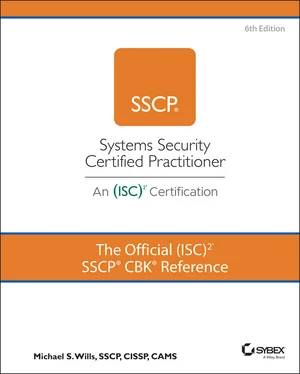Mike Wills - The Official (ISC)2 SSCP CBK Reference
Здесь есть возможность читать онлайн «Mike Wills - The Official (ISC)2 SSCP CBK Reference» — ознакомительный отрывок электронной книги совершенно бесплатно, а после прочтения отрывка купить полную версию. В некоторых случаях можно слушать аудио, скачать через торрент в формате fb2 и присутствует краткое содержание. Жанр: unrecognised, на английском языке. Описание произведения, (предисловие) а так же отзывы посетителей доступны на портале библиотеки ЛибКат.
- Название:The Official (ISC)2 SSCP CBK Reference
- Автор:
- Жанр:
- Год:неизвестен
- ISBN:нет данных
- Рейтинг книги:4 / 5. Голосов: 1
-
Избранное:Добавить в избранное
- Отзывы:
-
Ваша оценка:
- 80
- 1
- 2
- 3
- 4
- 5
The Official (ISC)2 SSCP CBK Reference: краткое содержание, описание и аннотация
Предлагаем к чтению аннотацию, описание, краткое содержание или предисловие (зависит от того, что написал сам автор книги «The Official (ISC)2 SSCP CBK Reference»). Если вы не нашли необходимую информацию о книге — напишите в комментариях, мы постараемся отыскать её.
The Official (ISC)2 SSCP CBK Reference
SSCP Study Guide
The Official (ISC)2 SSCP CBK Reference
The Official (ISC)2 SSCP CBK Reference — читать онлайн ознакомительный отрывок
Ниже представлен текст книги, разбитый по страницам. Система сохранения места последней прочитанной страницы, позволяет с удобством читать онлайн бесплатно книгу «The Official (ISC)2 SSCP CBK Reference», без необходимости каждый раз заново искать на чём Вы остановились. Поставьте закладку, и сможете в любой момент перейти на страницу, на которой закончили чтение.
Интервал:
Закладка:
 OECD Privacy Principles: Basic Principles of National Application
OECD Privacy Principles: Basic Principles of National Application
The OECD Privacy Principles are used throughout many international privacy and data protection laws and are also used in many privacy programs and practices. The eight privacy principles are as follows:
1 Collection Limitation Principle: This principle states that data that is collected should be obtained by lawful and fair means, that the data subject should be aware of and consent to the collection of the data where appropriate, and that the quantity and type of data should be limited.
2 Data Quality Principle: This principle is aimed at the accuracy and completeness of data, whether it is appropriately maintained and updated, and whether the data retained is relevant to the purposes it is used for.
3 Purpose Specification Principle: Purpose specification means that the reasons that personal data is collected should be determined before it is collected, rather than after the fact, and that later data reuse is in line with the reason that the data was originally obtained.
4 Use Limitation Principle Security: This principle notes that release or disclosure of personal data should be limited to the purposes it was gathered for unless the data subject agrees to the release or it is required by law.
5 Security Safeguards Principle: Reasonable security safeguards aimed at preventing loss, disclosure, exposure, use, or destruction of the covered data are the focus of this principle.
6 Openness Principle: The principle of openness is intended to ensure that the practices and policies that cover personal data are accessible and that the existence of personal data, what data is collected and stored, and what it is used for should all be disclosed. Openness also requires that the data controller's identity and operating location or residence is openly disclosed.
7 Individual Participation Principle: This includes an individual's right to know if their data has been collected and stored and what that data is within a reasonable time and in a reasonable way. In addition, this principle allows the subject to request that the data be corrected, deleted, or otherwise modified as needed. An important element of this principle is the requirement that data controllers must also explain why any denials of these rights are made.
8 Accountability Principle: The final principle makes the data controller accountable for meeting these principles.
The OECD Privacy Guidelines can be found at www.oecd.org/internet/ieconomy/privacy-guidelines.htm.
In developing the guidelines, the OECD recognized the need to balance commerce and other legitimate activities with privacy safeguards. Further, the OECD recognizes the tremendous change in the privacy landscape with the adoption of data breach laws, increased corporate accountability, and the development of regional or multilateral privacy frameworks.
Asia-Pacific Economic Cooperation Privacy Framework
The Asia-Pacific Economic Cooperation (APEC) Privacy Framework establishes a set of common data privacy principles for the protection of personally identifiable information as it is transferred across borders. The framework leverages much from the OECD Privacy Guidelines but places greater emphasis on the role of electronic commerce and the importance of organizational accountability. In this framework, once an organization collects personal information, the organization remains accountable for the protection of that data regardless of the location of the data or whether the data was transferred to another party.
The APEC Framework also introduces the concept of proportionality to data breach—that the penalties for inappropriate disclosure should be consistent with the demonstrable harm caused by the disclosure. To facilitate enforcement, the APEC Cross-border Privacy Enforcement Arrangement (CPEA) provides mechanisms for information sharing among APEC members and authorities outside APEC.
It's beyond the scope of this book to go into much depth about any of these particular frameworks, legal systems, or regulatory systems. Regardless, it's important that as an SSCP you become aware of the expectations in law and practice, for the communities that your business serves, in regard to protecting the confidentiality of data you hold about individuals you deal with.
PII and NPI
Many information security professionals are too well aware of personally identifiable information (PII) and the needs in ethics and law to protect its privacy. If you've not worked in the financial services sector, you may not be aware of the much broader category of nonpublished personal information (NPI). The distinction between these two seems simple enough:
PII is that information that is used to identify, locate, or contact a specific person.
NPI is all information regarding that person that has not been made public and is not required to be made public.
However, as identity and credential attacks have grown in sophistication, many businesses and government services providers have been forced to expand their use of NPI as part of their additional authentication challenges, when a person tries to initiate a session with them. Your bank, for example, might ask you to confirm or describe some recent transactions against one of your accounts, before they will let a telephone banking consultation session continue. Businesses may issue similar authentication challenges to someone calling in, claiming to be an account representative from a supplier or customer organization.
Three important points about NPI and PII need to be kept in mind:
Legal definitions are imprecise and subject to continuous change. Many different laws, in many jurisdictions, may directly specify what types of information are considered as PII or NPI. Other laws may make broad categorical statements about what is or is not PII or NPI. These laws are updated often and subject to review by the courts in many nations.
Doing business in a jurisdiction does not require physical presence there. If your organization has one customer or supplier in a jurisdiction – possibly even a single prospective such relationship – that government may consider its laws and regulations now apply to you. Ignoring this is a frequent and costly mistake that many businesses make.
Persons include companies and organizations as well as natural people. Businesses and organizations share significant quantities and types of information with each other, much of which they do not wish to have made public. Privacy considerations and the need for information security protections apply here, as well as they do to data about individual people.
It may be safest to treat all data you have about any person you deal with as if it is NPI, unless you can show where it has been made public. You may then need to identify subsets of that NPI, such as health care, education, or PII, as defined by specific laws and regulations, that may need additional protections or may be covered by audit requirements.
Private and Public Places
Part of the concept of privacy is connected to the reasonable expectation that other people can see and hear what you are doing, where you are (or are going), and who might be with you. It's easy to see this in examples: Walking along a sidewalk, you have every reason to think that other people can see you, whether they are out on the sidewalk as well, looking out the windows of their homes, offices, or passing vehicles. The converse is that when out on that public sidewalk, out in the open spaces of the town or city, you have no reason to believe that you are not visible to others. This helps differentiate between public places and private places .
Читать дальшеИнтервал:
Закладка:
Похожие книги на «The Official (ISC)2 SSCP CBK Reference»
Представляем Вашему вниманию похожие книги на «The Official (ISC)2 SSCP CBK Reference» списком для выбора. Мы отобрали схожую по названию и смыслу литературу в надежде предоставить читателям больше вариантов отыскать новые, интересные, ещё непрочитанные произведения.
Обсуждение, отзывы о книге «The Official (ISC)2 SSCP CBK Reference» и просто собственные мнения читателей. Оставьте ваши комментарии, напишите, что Вы думаете о произведении, его смысле или главных героях. Укажите что конкретно понравилось, а что нет, и почему Вы так считаете.












